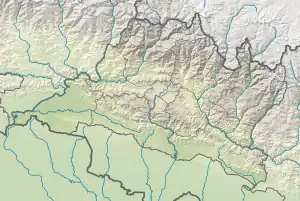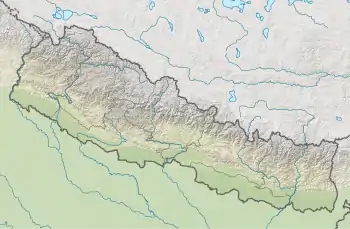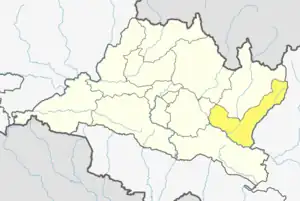Likhutamakoshi Rural Municipality
Likhutamakoshi is a Rural municipality located within the Ramechhap District of the Bagmati Province of Nepal. The municipality spans 124.51 square kilometres (48.07 sq mi) of area, with a total population of 23,109 according to a 2011 Nepal census.[1][2]
Likhu (RM)
लिखु गाउँपालिका | |
|---|---|
 Likhu (RM) Location  Likhu (RM) Likhu (RM) (Nepal) | |
| Coordinates: 27°25′33″N 86°10′35″E | |
| Country | |
| Province | Bagmati |
| District | Ramechhap District |
| Wards | 7 |
| Established | 10 March 2017 |
| Government | |
| • Type | Rural Council |
| • Chairperson | Mr. Keshab Mahat |
| • Vice-chairperson | Mrs. Dipa Pakhrin |
| • Term of office | (2022 - 2027) |
| Area | |
| • Total | 124.51 km2 (48.07 sq mi) |
| Population (2011) | |
| • Total | 23,109 |
| • Density | 190/km2 (480/sq mi) |
| Time zone | UTC+5:45 (Nepal Standard Time) |
| Headquarter | Bijulikot |
| Website | likhumunramechhap |
On March 10, 2017, the Government of Nepal restructured the local level bodies into 753 new local level structures.[3][4] The previousDuragau, Saipu, Bijulikot, Nagdaha, Khimti and Tilpung VDCs were merged to form Likhutamakoshi Rural Municipality. Likhutamakoshi is divided into 7 wards, with Bijulikot declared the administrative center of the rural municipality.
Demographics
At the time of the 2011 Nepal census, Likhutamakoshi Rural Municipality had a population of 23,135. Of these, 56.6% spoke Nepali, 23.1% Tamang, 7.1% Magar, 6.4% Sunwar, 4.3% Newar, 0.9% Yolmo, 0.3% Majhi, 0.2% Gurung, 0.1% Maithili, 0.1% Sherpa, 0.1% Tharu and 0.1% other languages as their first language.[5]
In terms of ethnicity/caste, 31.8% were Chhetri, 23.6% Tamang, 10.3% Magar, 10.1% Newar, 6.5% Sunuwar, 5.5% Hill Brahmin, 3.2% Kami, 2.7% Sarki, 2.0% Damai/Dholi, 1.7% Gharti/Bhujel, 0.9% Yolmo, 0.4% Sanyasi/Dasnami, 0.3% Badi, 0.3% Gurung, 0.3% Majhi, 0.2% Tharu, 0.1% Sherpa and 0.2% others.[6]
In terms of religion, 70.7% were Hindu, 26.0% Buddhist, 2.4% Christian, 0.3% Bon and 0.6% others.[7]
In terms of literacy, 63.9% could read and write, 3.9% could only read and 32.0% could neither read nor write.[8]
References
- "District Corrected Last for RAJAPATRA" (PDF). www.mofald.gov.np. Retrieved 17 July 2018.
- "स्थानीय तहहरुको विवरण" [Details of the local level bodies]. www.mofald.gov.np/en (in Nepali). Ministry of Federal Affairs and Local Development. Retrieved 17 July 2018.
- "New local level structure comes into effect from today". www.thehimalayantimes.com. The Himalayan Times. 10 March 2017. Retrieved 17 July 2018.
- "New local level units come into existence". www.kathmandupost.ekantipur.com. 11 March 2017. Retrieved 18 July 2018.
- NepalMap Language
- NepalMap Caste
- NepalMap Religion
- NepalMap Literacy
